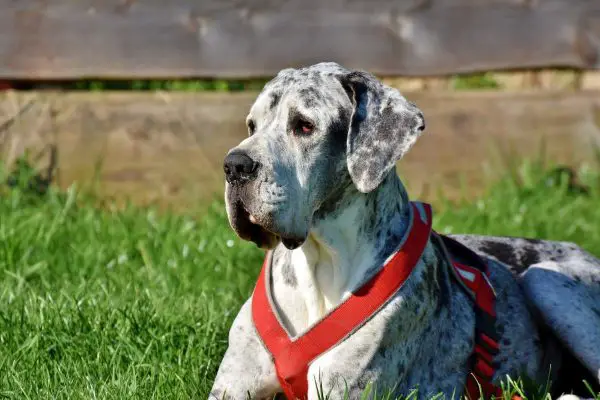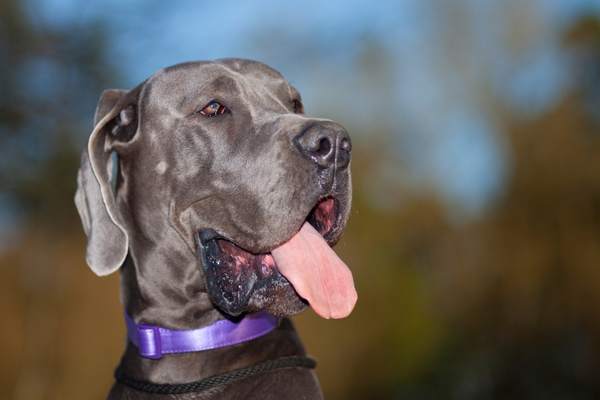The Great Dane is a breed of dog that has captivated people for centuries with its majestic presence, gentle demeanor, and loyal nature. But what really makes this breed so special and sets them apart from other breeds? In this article we will take a closer look at some of the defining characteristics of Great Danes. Read on to discover more about this remarkable breed.
14 Characteristics of Great Danes
From the stunning size to the friendly personality, here are 14 of the most notable characteristics of Great Danes.
1. Tallest Dog Breed

Great Danes are not only a majestic and beautiful dog breed but also the tallest breed in the world. In fact, the Guinness Book of World Records crowned a Great Dane named Zeus as the tallest dog on record, measuring 44 inches from paw to shoulder.
He measures an impressive 7 feet 4 inches when standing on his hind legs. However, the average height of an adult Great Dane is around 30 to 32 inches for males and 28 to 30 inches for females.
Its imposing height is primarily due to its long legs, which, coupled with its large paws, help them maintain balance when running at full speed. They also have deep chests and strong bones, which help them carry their large frame.
2. Gentle Nature
Despite their imposing size, Great Danes are known for their gentle, loving nature. They are incredibly loyal and protective of their family, making them great companions and watchdogs. They are also very gentle and patient with children, making them ideal family pets.
Great Danes are friendly with other animals, including cats and smaller dogs. However, they can become overly protective of their family and may not get along with strangers. As such, it is important to socialize them from a young age so they can learn how to interact appropriately with other animals and humans.
3. Strong Hindquarters

The hindquarters of the Great Dane are strong and muscular. They should have good angulation, which is a measure of the angle between the thighbone (femur) and shinbone (tibia).
This angulation enables the dog to move with power, agility, speed, and balance. The hocks should be well-bent; cow hocks are a fault in Great Danes.
The feet should be round and catlike, with toes evenly spaced and arched. The pads should be hard and thickly cushioned. Dewclaws may or may not be present on the rear legs, but if they are present, they must not touch the ground when the dog is standing normally.
4. Long, Muscular Neck
The Great Dane has a long and muscular neck, typically with a slight arch at the crest. The neck is strong and broad and tapers slightly as it descends from the head to the shoulders.
It blends smoothly into the shoulders and gives off an impression of strength and power. The skin on the neck is loose, allowing for a great range of movement. The neck is covered in short and smooth hair, usually lighter in color than the rest of the body.
Additionally, some Great Danes may have a slight ruff of fur around their neck to add a regal look. Overall, the neck is an important part of the Great Dane’s structure, providing balance and support.
5. Magnificent Ears

The ears of the Great Dane are one of the defining features of this breed. They are set high on the head and should be large, wide, and triangle-shaped. The leather of the ear should be firm yet soft, and the ear should hang flat against the head.
Cropping of the ears is a common practice for this breed, but it is not required. This procedure involves surgically removing part of the ear and then allowing them to stand erect when healed. It is not recommended for pet dogs, as it is an unnecessary procedure and can cause discomfort.
6. Short Coat With Color Variations
Great Danes have short and smooth coats which lie close to the body. The hair should be thick enough to provide protection but not so thick that it restricts movement or looks unkempt. Common colors for this breed include fawn, blue, black, harlequin (a white base with black patches), mantle (black-and-white), and brindle (striped pattern).
They may also have white markings on their muzzle, chest, feet, and tail tip. Grooming requirements are minimal since the coat does not require much maintenance; brushing once a week is usually sufficient to keep it looking neat.
7. Drooling Tendency

Unfortunately, Great Danes are known for their tendency to drool. This is because of their facial composition; they have a square jaw and loose lips, which encourage saliva to pool in their mouths and drip out.
They may also drool after eating or drinking. Although this can be a nuisance, it is not usually a cause for concern and can easily be managed with regular wiping or wiping down of the mouth area.
However, some Great Danes may drool more than others, so if your dog’s drooling becomes excessive or is accompanied by other signs, such as difficulty swallowing, contact your veterinarian for advice. Additionally, try to avoid foods that are high in fat or sodium, which can encourage drooling.
8. Prominent Jowls
The jowls of a Great Dane stand out prominently from the rest of its facial features. This is due to their loose lips and large, square jaw, which cause their jowls to hang down from either side of their mouth.
These jowls help give this breed its signature look but also contribute to its drooling habit. The jowls should be firm and have a good muscle tone.
9. Long Tail

The tail of the Great Dane is long and should reach the hock. It should be thick at the base and taper to a point. It should hang low when relaxed but may curve slightly upwards when excited.
The coat on the tail should be short and smooth and should not be excessively long or wiry. The tail should move freely and should never be docked (surgically removed).
Happy Tail Syndrome (or “happy tail”) is common in the magnificent breed. It occurs when the dog wags its tail too hard and too fast, which causes the tip of its tail to slam against any hard surface resulting in skin wounds, tears, and even broken bones. This can be painful for the dog and can lead to infection, blood loss, and even permanent damage if left untreated.
10. Relatively Strong Bite
Despite its gentle and affectionate nature, the Great Dane has a relatively strong bite. It has been shown that this breed is capable of exerting about 238 pounds of force when it bites down.
This is around the same as the bite force of a German Shepherd. This can be dangerous if the dog is not trained and socialized properly, so it is important to ensure that your Great Dane receives appropriate training and socialization from an early age.
11. Majestic Gait

The gait of the Great Dane is unique and powerful, a sight to behold. With its long strides, it glides easily and effortlessly over the terrain with no rolling, bouncing, or bobbing of the body’s topline. Its backline appears level and parallel to the ground throughout its movement, while its reach strikes the ground below its nose.
The strength of its rear-drive is perfectly balanced with its reach for an impressive display of poise and power. As the speed increases, it naturally tends towards a centerline beneath its body as its legs converge inwards. Through all this motion, there is no twisting at either elbow or hock joints.
12. Broad Tongue
Great Danes have a broad and flat tongue that is usually pink but may have black spots or patches. This can be seen when they play or eat, as they often have their tongues hanging out of their mouths.
The tongue should not be excessively long or overly large relative to the size of the head. If your dog’s tongue is excessively large or feels thick in your hand, contact your veterinarian for advice.
13. Relatively Short Lifespan

The average life expectancy of the Great Dane is 7 to 10 years, with 8 being the average. It’s important to take special care of your dog, as health problems can arise due to its size and may reduce its lifespan even further. Be sure to provide them with a nutritious diet, regular exercise, and plenty of love.
14. Rapid Growth Spurts
The growth of a Great Dane is nothing short of remarkable. From birth until six months, they can grow to as much as 26-33 inches tall and weigh between 65 to 100 pounds. This rapid growth spurt can cause them to be a bit clumsy and awkward during these months since their body is changing so quickly.
However, between 18 and 24 months of age, most Great Danes are considered fully grown. They will reach their full height and add muscle to their frame during this time.

